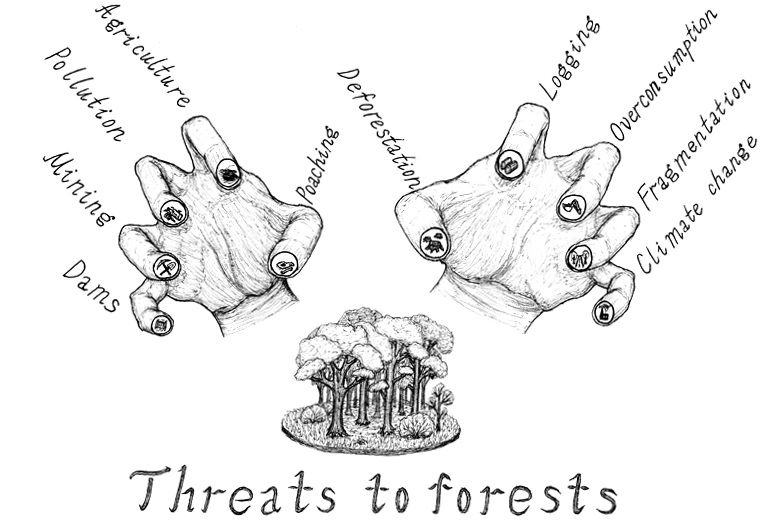
Welcome back, dear Friend! In the previous trainings, we talked about the forest ecosystems, the benefits and gains they bring to us, and the influence they have on our wellbeing and probably welfare. However, this relationship between the forest and us is not one-sided. We also affect the state of the natural resources and ecosystems in the forest. Unfortunately, this effect is not so positive. In fact, forests all over the world are threatened by the expanding human population and the pressure that the population exert on the natural environment, including the forest. Let us explore how we, humans, influence the forest and what we can do about it.
The most common way in which we use natural resources in a forest is the direct consumption of these resources. If you recall the Total Economic Value, this is related to the direct use values in the framework.
What we commonly use is timber: we build houses with it, we burn it to get heat energy, we sell it to some construction or furniture company, and so on. In order to gain this timber, we need to cut trees. If it is done sustainably, then there is no significant damage to the forest ecosystem.
The trouble starts, when we invade into a natural, pristine forest and start cutting its trees with heavy machinery without considering the forest regrowth rates, the impact we have on the forest ecosystem, on its biodiversity, and so on. This usually happens because of companies’ rush for profits, unsustainable practices of forest management, wrong economic incentives, inefficient legislation, and so on. The consequences of that can be the degradation of the forest ecosystem, loss of its biodiversity, and total disruption in the provisioning of its ecosystem services.
Not only trees are vulnerable to human “consumption”. Also, medicinal plants, berries, mushrooms, and other non-timber products in a forest can become victims of unsustainable human desires. So, people can pick them and use them for their purposes. But if these species are in the category of vulnerable or endangered, then their unsustainable collection can be a real damage to the natural ecosystem in the forest.
Uncontrolled hunting and poaching are other harmful human interventions into the forest ecosystem. If they affect vulnerable and endangered species of animals in the forest, this can make a serious blow to the stability of the natural environment and biodiversity in the forest. For example, in the Codru forest, there are about 100 to 800 cases of illegal logging and poaching registered every year, and these are only official numbers.
Waste pollution is another common enemy of forest ecosystems. Certainly, the recreational value of forests attracts people to come to forests, to visit them, to enjoy walking in the woods, to have a picnic amongst this beauty of trees and leaves, and so on. However, if people are not used to taking their trash with them and to cleaning up the space around them, then what is left after their recreational enjoyment are piles of solid and organic waste that pollute the environment. One can usually find there packaging waste, like plastic bottles and food containers, and some food waste. However, the consequence of this pollution is not only mere displeasure of seeing trash sites all over the forest. Waste actually penetrates into the soil and contaminates both the soil and groundwater, thus undermining fertility of the soil and disrupting natural processes that happen in the soil. Also, animals can mix up various waste items for food and can swallow them and die from indigestion because of these waste items. Therefore, it is very important to leave picnic sites and other places as clean as possible, to take all trash with you, and to dispose it into proper waste management facilities.
Finally yet importantly, mere disturbance by logging machinery, noisy tourists, or road traffic nearby can be damaging to the stability of the natural ecosystem. Animals disturbed by all these noises can move to other locations. However, forest has its limits. So, if the disturbance from people and machinery is present all over the forest, then animals have nowhere to go, and they remain suffering from all the noise pollution produced by humans.
Certainly, there are many other ways, in which we affect forest ecosystems, both directly and indirectly. One can mention here deforestation and soil degradation due to changing land use, like conversion of forests into agricultural lands, forest fires, consequences of climate change, and many other. It seems that while forests give us all the benefits and gains practically for free, we “return the favour” by degrading and destroying them.

Figure 1. Major human induced threats to forests.
At this point, you may ask, “So, if we gain so much from forests, as the economic valuation research suggests, why do we continue to pollute, damage, and destroy forest ecosystems?” And one more interesting question to ask is if we know so much about the benefits and value of forest ecosystems to us and our wellbeing, how we can use this to reverse the trend and to minimize the negative effects of human intervention on forests. These are very interesting questions, and we will reflect upon them in the upcoming training of the course. See you there!
DISQUS COMMENTS WILL BE SHOWN ONLY WHEN YOUR SITE IS ONLINE